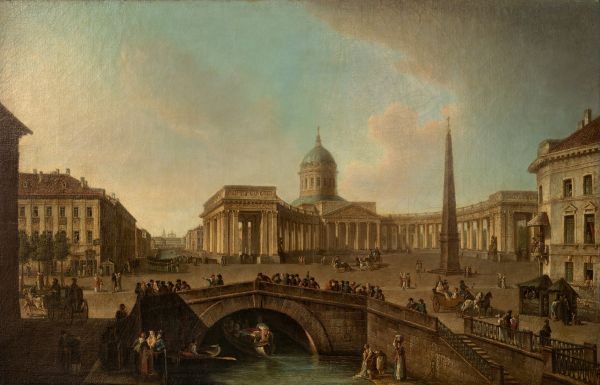|
|
View of the Kazan Cathedral in St Petersburg

Alexeyev Fyodor,
Oil on canvas
71 х 112,5
State Russian Museum
Annotation
The Kazan Cathedral in St Petersburg is one of the most important churches in the Orthodox world. It houses one of the two most venerated duplications of the Our Lady of Kazan icon, the patroness of the imperial house and the protector of the Russian land. The cathedral, built from 1801–1811 from a design by Andrei Voronikhin, was intended to emphasise the political aspirations of the Russian Empire. The majestic colonnade of the cathedral, spreading out toward Nevsky Prospect, is reminiscent of St Peter’s Basilica in Rome. This is the influence of both the romantic interest in Catholicism and the mission of Russia in the greater Christian world. In the solemn rhythm of the forms of the orders of Classical architecture, undoubtedly, there is a kind of heroic sensibility. And it is no wonder that after Napoleon’s expulsion from Russia, Kazan Cathedral became a war memorial, where in 1813 the ashes of Field Marshal Mikhail Kutuzov were laid to rest, and trophies of the Patriotic War of 1812 were housed: flags, banners, and keys to forts and cities.
Fyodor Alexeyev depicts Andrei Voronikhin’s Kazan Cathedral and the original layout of the adjoining square. The wooden obelisk crowned with a cross stood in the centre of the square until 1826. Ivan Martos’s plaster figures of St Gabriel the Archangel and St Michael the Archangel stand at the ends of the colonnade. Pendant statues of Field Marshal Mikhail Kutuzov and Field Marshal Michael Barclay de Tolly were opened outside the Kazan Cathedral in 1837.
Author's Biography
Alexeyev Fyodor
Alexeyev, Fyodor Yakovlevich
1753/1754 (?). St Petersburg - 1824, St Petersburg
Painter, founding father of the Russian school of urbanscape painting. Son of a guard at the Imperial Academy of Arts. Studied fruit and flower and landscape painting at the Imperial Academy of Arts (1766-73). Awarded a fellowship to Venice (1773-77). Studied under Giuseppe Moretti and Pietro Gaspari. Returned to St Petersburg and worked as a painter for the Imperial Theatres (1799). Copied paintings by Canaletto and Bernardo Bellotto for Catherine the Great. Nominated to the Academy (1794). Sketched places visited by Catherine the Great (1787) in south Russia (1795). Painted urbanscapes in Moscow (1800). Councillor of the Imperial Academy of Arts (1802), Taught perspective painting at the Imperial Academy of Arts (1803-24).

